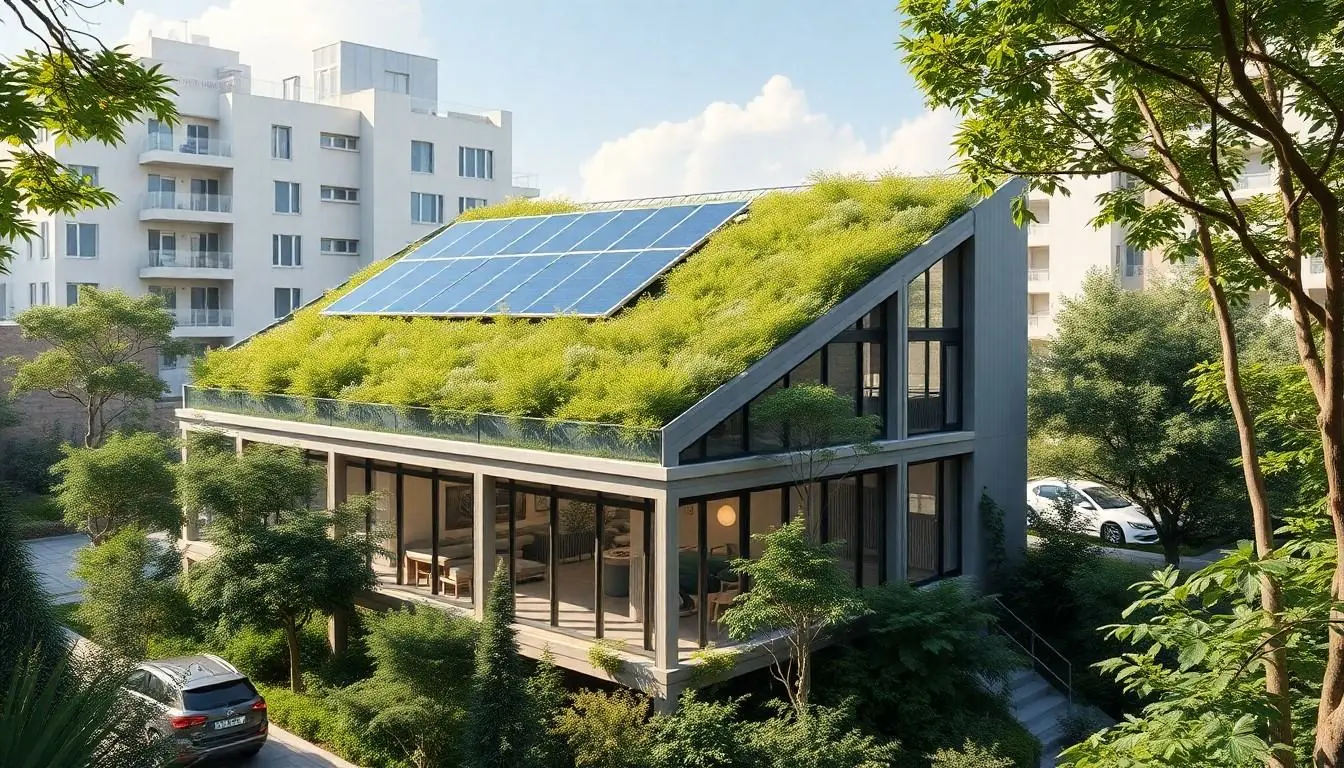Table of Contents
ToggleIn a world where Mother Nature is giving us the side-eye, sustainable building technology is the superhero we didn’t know we needed. Gone are the days of constructing buildings that suck the life out of the planet. Instead, architects and builders are turning to innovative solutions that not only save energy but also make the environment smile. Who knew saving the Earth could be so stylish?
Imagine a future where homes breathe, roofs harvest sunlight, and walls are made from recycled materials. Sustainable building technology isn’t just a trend; it’s a necessity. As the construction industry embraces eco-friendly practices, it’s time to dive into the fascinating world of green architecture. Get ready to discover how these advancements are transforming our skylines and paving the way for a cleaner, greener tomorrow.
Overview of Sustainable Building Technology
Sustainable building technology integrates eco-friendly practices into construction methods and materials. This technology emphasizes energy efficiency, reducing waste, and utilizing renewable resources. Implementing solar panels can significantly lower energy consumption in residential and commercial buildings. Rainwater harvesting systems also promote resource conservation by collecting and using rain for irrigation and sanitation.
Many architects and builders now focus on recycled materials. These materials, such as reclaimed wood and recycled steel, decrease the environmental impact associated with extracting new resources. Green roofs provide insulation and reduce urban heat, contributing to energy savings and biodiversity. Moreover, advanced insulation techniques enhance thermal performance, minimizing the need for heating and cooling.
Systems like Leadership in Energy and Environmental Design (LEED) certification ensure buildings meet specific sustainability criteria. This certification encourages developers to adopt practices that minimize ecological footprints. Additionally, smart building technologies utilize sensors and automation to optimize energy use, further enhancing efficiency and sustainability.
Local sourcing of building materials supports the economy and lowers transportation emissions. Challenges persist in adopting sustainable technologies, including higher upfront costs and regulatory barriers. Nevertheless, long-term benefits, such as reduced operational costs and increased property value, offset initial investments. With a growing awareness of climate change, sustainable building technology represents a vital step toward a healthier planet and sustainable future.
Key Principles of Sustainable Building Technology

Sustainable building technology prioritizes practices that enhance the environmental performance of structures. It focuses on minimizing resource use while maximizing efficiency and overall impact.
Energy Efficiency
Energy efficiency remains a cornerstone of sustainable building technology. The integration of energy-saving systems such as solar panels reduces reliance on fossil fuels. Advanced insulation techniques maintain comfortable indoor temperatures, minimizing heating and cooling demands. Energy management systems track and optimize consumption patterns, ultimately lowering utility costs. Studies show that energy-efficient buildings can reduce energy use by up to 30%, significantly lowering carbon footprints.
Resource Conservation
Resource conservation plays a crucial role in sustainable building practices. Utilizing recycled materials like reclaimed wood and recycled steel minimizes waste and reduces the need for new raw materials. Efficient water management systems, including rainwater harvesting, support environmental sustainability by reducing freshwater consumption. Local sourcing of materials decreases transportation emissions, supporting nearby economies. Implementing strategies focused on resource conservation can lead to substantial savings and a reduced environmental impact.
Environmental Impact
Environmental impact assessments are integral to sustainable building technology. Green roofs enhance biodiversity, improve insulation, and help manage stormwater runoff. Building designs that incorporate natural lighting and ventilation reduce energy dependence, promoting a healthier living environment. LEED certification sets benchmarks for sustainability, encouraging adherence to eco-friendly practices. Evidence indicates that sustainable buildings can improve indoor air quality, resulting in better health outcomes for occupants and communities.
Types of Sustainable Building Technologies
Sustainable building technologies encompass various innovative methods that enhance environmental performance. These technologies directly contribute to energy efficiency and resource conservation.
Green Materials
Green materials play a pivotal role in sustainable construction. Options like reclaimed wood and recycled steel minimize the extraction of new resources. Low-VOC paints and finishes promote healthier indoor air quality through fewer harmful emissions. Bamboo stands out as a rapidly renewable alternative, providing both durability and aesthetic appeal. Incorporating these materials can result in reduced waste, thus lessening the overall environmental footprint of a building.
Renewable Energy Solutions
Renewable energy solutions significantly decrease reliance on fossil fuels. Solar panels, installed on rooftops or ground mounts, convert sunlight into electricity, reducing energy costs. Wind turbines can also generate clean energy, suitable for larger properties. Geothermal heating and cooling systems harness the Earth’s constant temperature, offering efficient climate control year-round. These renewable technologies not only lower utility bills but also contribute to a sustainable energy ecosystem.
Smart Home Systems
Smart home systems integrate technology to enhance energy efficiency and convenience. Thermostats automatically adjust temperatures based on occupancy, optimizing heating and cooling. Lighting systems use sensors to reduce energy use when spaces are unoccupied. Smart meters provide real-time data on energy consumption, empowering users to manage usage effectively. By embracing these systems, buildings can operate more efficiently, promoting sustainability and improving overall living conditions.
Benefits of Implementing Sustainable Building Technology
Implementing sustainable building technology offers numerous advantages that extend beyond environmental concerns.
Economic Advantages
Cost savings represent a significant benefit of sustainable building technology. Reduced energy consumption directly lowers utility bills, leading to substantial long-term savings. Property value often increases for buildings utilizing green methods due to higher demand among eco-conscious buyers. Additionally, government incentives like tax credits may offset initial investment costs for sustainable practices. Reduced operational costs over time make sustainable buildings financially advantageous.
Health and Well-Being
Improved indoor air quality plays a crucial role in enhancing health and well-being. Sustainable building technologies, such as using low-VOC materials, contribute to a healthier living environment. Natural lighting systems benefit occupants by boosting mood and productivity. Accessible green spaces encourage outdoor activity, facilitating physical health. Sustainable practices often result in better ventilation, which reduces allergens and pollutants, promoting overall health.
Long-term Sustainability
Long-term sustainability significantly impacts the future environmental landscape. Sustainable buildings frequently employ renewable energy sources, lessening dependence on fossil fuels. Additionally, resource conservation practices, like recycling and efficient water management, minimize waste and promote responsible consumption. Buildings designed with longevity in mind adapt more easily to changing environmental conditions. Sustainable technologies cultivate resilience in communities, promoting a balanced relationship between urban development and nature.
Challenges in Adopting Sustainable Building Technology
Adopting sustainable building technology presents various challenges that stakeholders encounter in the construction industry. Understanding these challenges helps in developing effective strategies for overcoming them.
Initial Costs
Initial costs represent a significant barrier to the adoption of sustainable building technology. Upfront investments often exceed those of traditional construction methods. For instance, solar panel installations and energy-efficient systems incur higher initial expenses. Although these technologies deliver long-term savings, many project owners hesitate due to immediate financial constraints. Budgeting for these technologies requires careful financial planning to balance long-term benefits with short-term costs. Without addressing these initial costs, stakeholders may struggle to justify the transition.
Regulatory Barriers
Regulatory barriers hinder the widespread implementation of sustainable building technology. Complex building codes and zoning laws frequently complicate the approval process for eco-friendly projects. Moreover, some existing regulations may not align with innovative sustainable practices. These misalignments create hurdles for architects and builders striving for sustainability. Inconsistent enforcement and varying local regulations can also contribute to confusion among developers. Understanding these barriers is essential for advancing sustainable initiatives and encouraging compliance with both current regulations and emerging standards.
Sustainable building technology represents a significant leap toward a more eco-friendly future. By integrating innovative practices and renewable resources, it not only addresses pressing environmental concerns but also enhances the quality of life for communities.
The long-term benefits outweigh initial costs, making it a wise investment for property owners and developers. As awareness grows and regulations evolve, the adoption of these technologies will pave the way for greener urban landscapes.
Embracing sustainable building practices is essential for fostering resilience and ensuring a balanced relationship between development and nature. The journey toward sustainability is just beginning, and its impact will resonate for generations to come.






